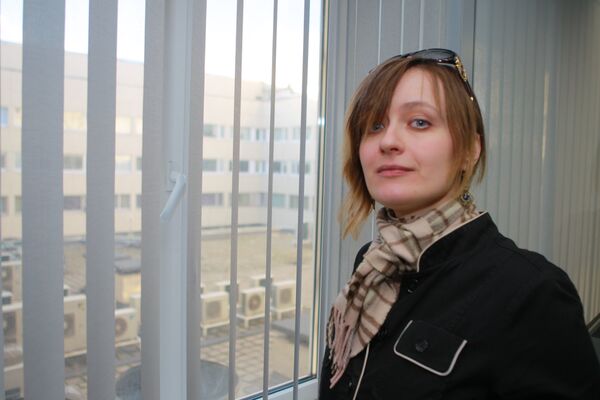“Happy International Women’s Day!” A huge billboard near Novy Arbat proclaimed. As per Soviet tradition, the text was superimposed on a hideous picture of pink flowers, showcasing the kind of nature photography that went out of style before I was born. I studiously averted my eyes - it was all too embarrassing, a bit like seeing a madman drop his trousers in the middle of a busy intersection.
The fact that March 8 has long been a consumerist holiday more akin to Valentine’s Day than to a day marking women’s achievements is old news. Much virtual ink has been spilled on the subject, and many laments have issues - both from Russians and foreigners alike.
But the way in which March 8 often incorporates Soviet kitsch is a phenomenon that’s worth of a closer look, methinks. And by “Soviet kitsch,” I don’t mean busts of Lenin decorated with flowers and lipstick (hm, that could possibly even be cool, at least for five minutes or so), but the kind of aggressive bad taste that bureaucrats tend to enjoy and promote.
This isn’t just a problem for the city center, the “greetings” taped on the noticeboard of our apartment building, as well as every apartment building within a certain radius, were equally hideous. Pink flowers, ribbons, and a distorted, lifeless drawing of an aproned housewife that distantly resembled the mother from a beloved Soviet cartoon miniseries, “Prostokvashino” - oh my!
Such greetings make for an interesting concept with the more modern, sexualized meaning of March 8. A lot of people nowadays are nostalgic about the Soviet Union - and while we expect the very old to do this, the truth is, the young do it too. This especially goes for those who never experienced the USSR, or else just barely glimpsed it.
As writer Lyudmila Ulitskaya pointed out with her 2011 book The Green Tent, the younger generation is prone to romanticizing the past, even though for many people, living back then was hardly a cakewalk.
I don’t really understand people who refer to the USSR as “The Evil Empire” - the past is immutable, after all, both good parts and bad. But I do find it interesting that in celebrating women on March 8, we in Russia tend to go for aesthetic extremes: either we celebrate the commercial notion of femininity, that which comes packaged with a push-up bra and an expensive gym membership, or we tend to look towards some bland Soviet ideal.
I suppose the latter is also influenced by the fact that there are a whole lot of old and aging people in Russia, most of those old and aging people being women who outlive men by a great deal. For them, March 8 doesn’t exist in a modern context - and neither do they have the energy or the inclination to rethink its holiday and its roots. If their poor prospects as pensioners have made sure that they are still active in the workforce, March 8 is usually just treated as a welcomed day off.
Paying attention to images is often a purely academic exercise, of course. How do I know that I’m not reading too much into all of these billboards, and signs, and greeting cards? I guess that’s because I now tend to think that in its purest form, March 8 in Russia is really a celebration of spring; hence, all the freaking flowers and the desire to either sexualize or desexualize the holiday aesthetic.
Womanhood around here is tied to procreation, and procreation in turn is tied to nature awakening after a long winter sleep. What used to be a holiday tied to the achievements of female workers has gone pagan, I believe.
Hey, it’s the 21st century. Even poor people are getting gadget weary - if only from advertising alone. There must be something refreshing about looking to mother nature after all.
The views expressed in this article are the author's and do not necessarily represent those of RIA Novosti.
Trendwatching in Russia is an extreme sport: if you’re not dodging champagne corks at weddings, you’re busy avoiding getting trampled by spike heels on public transportation. Thankfully, due to an amazing combination of masochism and bravado, I will do it for you while you read all about it from the safety of your living room.
Natalia Antonova is the deputy editor of The Moscow News. She also works as a playwright – her work has been featured at the Lyubimovka Festival in Moscow and Gogolfest in Kiev, Ukraine. She was born in Ukraine, but spent most of her life in the United States. She graduated from Duke University, where she majored in English and Slavic Literature. Before coming to Moscow, she worked in Dubai, UAE and Amman, Jordan. Her writing has been featured in The Guardian, Foreign Policy, Russia Profile, AlterNet, et al.
Trendswatcher: Dinosaurs Stalking Moscow Playgrounds
Trendswatcher: Putin Quoted Lermontov and the Lit Geeks Rejoiced
Trendswatcher: Whitney Houston Is Dead, Long Live Whitney Houston
Trendswatcher: The Trouble with ‘Intimate’ English
Trendswatcher: When Looking ‘Normal’ is a Matter of Life and Death
Trendswatcher: An Education. The Foreign Kind
Trendswatcher: The rich also bruise
Trendswatcher: Marriage needs magic? Don’t go for the literal kind!

